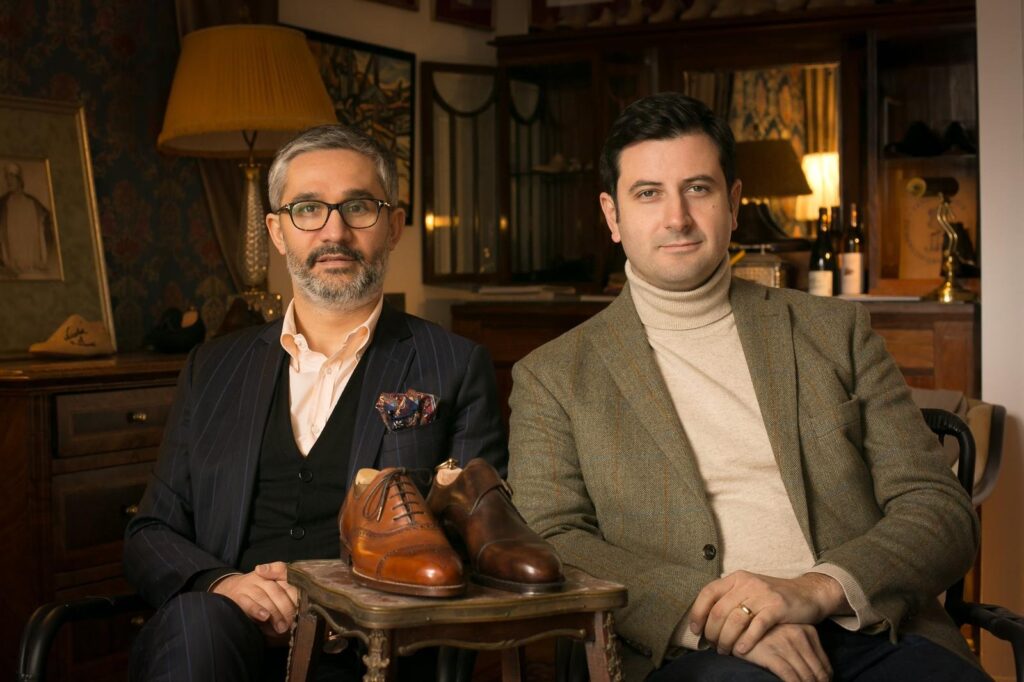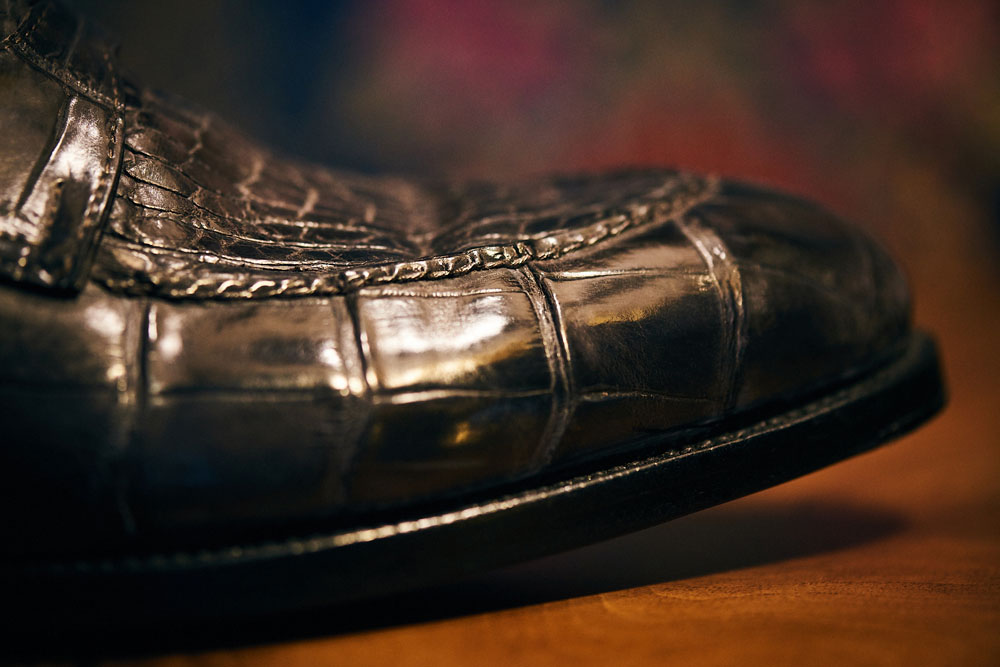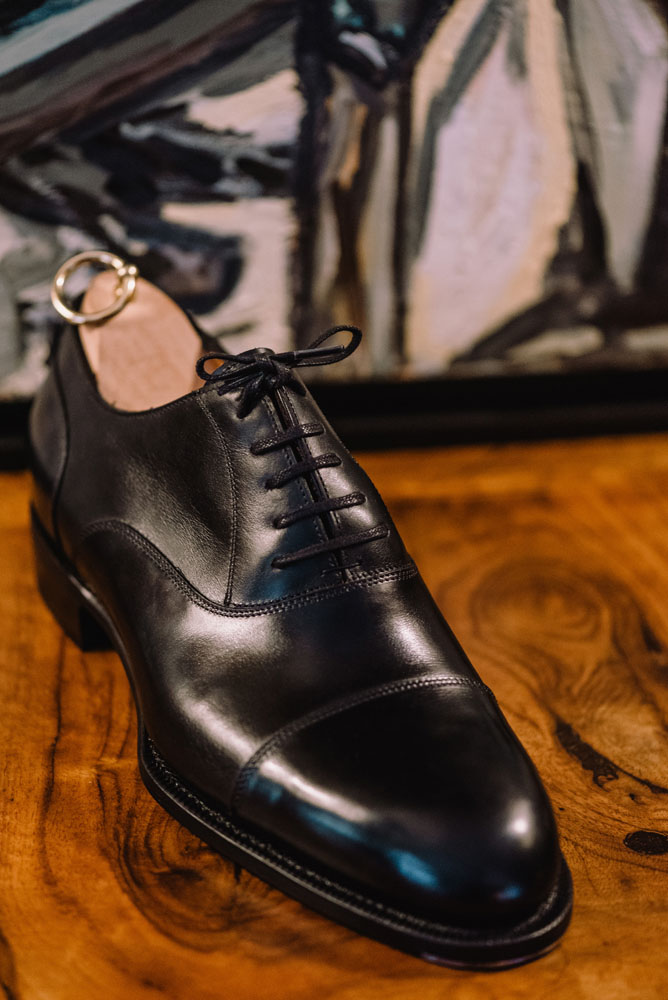Last year I visited Bucarest and by chance I met Mircea Cioponea. If you don’t know him you will probably know his blog Claymoorslist. He told me that he had just started the new bespoke shoe company Petru & Claymoor with his business partner Petru Coca. We met a couple of months later for a very insightful interview.

Bernhard Roetzel: Mircea, you are known as the founder of Claymoorslist. Why did you decide to change places and become a shoemaker yourself instead of writing about them?
Mircea Cioponea: Everything started with me encountering my business partner, Petru Coca. Previously, Petru has been involved in another shoemaking project in the Republic of Moldova. We certainly complete each other, although his business experience makes him more arduous than me. That being said, I confess that our common beginnings were not the smoothest. We have had the chance to meet an exquisite craftsman. Romania is quite interesting in what shoemaking is concerned, for it has particularly gifted artisans. Transylvania preserves the memory of this craftsmanship inherited from the Austro-Hungarians. Even with the Communist prolonged gap, this heritage is still alive and vibrant. South of the Carpathians, Bucharest itself had, until 1945, countless stores and bespoke workshops. I have recently seen a pair of shoes manufactured in Bucharest somewhere between 1940 and 1945. Technically, they were outstanding. Faultless stitches, perfectly cut uppers. Undoubtedly, there is a synchronicity between this level of perfection and what we are used to see in London or Vienna.
Moreover, Bucharest is a fascinating city. Starting with the second half of the Thirties, under the king Carol the Second, the city becomes the object of a major architectural make-over, which leads to an Art Deco modernist flourishment. Much has been built, the arts and crafts were given a tremendous boost, in order to appeal to a new social class, demanding such bespoke products. This has been the golden age of tailors, hatters and shoemakers, who were already taking the next step: from craft to art. It`s this carefully curated tradition that we envisage to continue and to grow. Shoes have a memory that encapsulates the past of an enticing city and the footprints of a timeless, elegant society. I am quite fond of the lyrics of a Bruce Springsteen song, Atlantic City – “Everything dies baby that’s a fact / But maybe everything that dies someday comes back”. Somehow, our endeavour found us as much as we have built it. Maybe the shoes choose us, not vice-versa.

How can you run a bespoke shoe business if you are not a shoemaker
yourself?
Moreover, Bucharest is a fascinating city. Starting with the second half of the Thirties, under the king Carol the Second, the city becomes the object of a major architectural make-over, which leads to an Art Deco modernist flourishment. Much has been built, the arts and crafts were given a tremendous boost, in order to appeal to a new social class, demanding such bespoke products. This has been the golden age of tailors, hatters and shoemakers, who were already taking the next step: from craft to art. It`s this carefully curated tradition that we envisage to continue and to grow. Shoes have a memory that encapsulates the past of an enticing city and the footprints of a timeless, elegant society. I am quite fond of the lyrics of a Bruce Springsteen song, Atlantic City – “Everything dies baby that’s a fact / But maybe everything that dies someday comes back”. Somehow, our endeavour found us as much as we have built it. Maybe the shoes choose us, not vice-versa.

Can you describe the style of Petru & Claymoor?
We are a bespoke studio, so we don`t really have our own style when compared to a ready-to-wear shoe brand. With us, it is the client who primarily gets to choose what his shoe will look like. One must consider that we are still young, so to speak. Most models are reinterpreted classics. Classic with a twist. What we do is to preserve a certain austerity, given our rather conservative clientele. For instance, we use a certain patina on the crust, but we never head towards the extravagant. We advocate for the simple, fluid lines and that links us with the Anglo-Saxon aesthetics, rather than French or Italian. Of course, I am not talking about loafers here. Romania has long summers, reaching beyond the calendar’s months. Therefore, we have a great deal of orders for loafers. Our new made-to-order line, “1881”, will burst a Italian flair. The Italian touch will be evident in these three new models. Later this year, early summer, we will launch the first prototype, something we wish to turn into an iconic Petru&Claymoor model.
Is there anything that you do differently than other bespoke makers?
Petru Coca: As we are part of the East-European market, we have to take into account our clientspreferences. Our standard buyer is a bit different compared to a Viennese one, for example. The finishing is highly important. We have perfected this aspect and we aim to get as close as possible to the Japanese vision. Shoemakers such as Yohei Fukuda or Masaru Okuyama are a constant inspiration. In order to be relevant for a young customer, the finishing is crucial. Currently, we praise ourselves with pure lines and the construction is impeccable. Our colleagues are an inspiration, too, and we do not let one month pass without improving something in our manufacturing process. In this field, one can never assert he or she knows everything. Design elements change, whether one likes it or not. The technical part goes through constant improvements. To answer more properly to your question, we dont do things differently from the established Western brands. We focus on a better finishing of our product. Being a family business, financially independent, we don`t settle for less regardless the aspect. There is no managing board demanding higher sales, no pressure from business partners, so we take the time to do things our way. If I am happy with the shoe, if I would wear it myself, then I can offer it to my customer. If not, we start from scratch.

What is your idea of a well-fitting bespoke shoe?
Petru Coca: For a bespoke shoemaker, the whole process starts with the trial shoe. The Romanian customers opt for a slightly wider shoe. I personally like the shoe to be really fit on the foot, but the fitting varies from client to client.
How do you go about measuring and fitting?
Petru Coca: We take measures in our workshop in Aleea Alexandru or at the customer’s home. After that, we create a last for the trial pair. Once the shoe is tried on, we perfect the last or we alter it, making another trial pair in order to notice the changes applied. We like our trial shoe to be an Oxford for observing better the fit. Once the last is finished, we store it on the shelf and wait for the next order.
If you look back at the first months of Petru&Claymoor, which
difficulties did you face?
Mircea Cioponea: Our project was quite accurately envisaged. Once you start, though, one discovers the need for plenty of things that prove to be harder to obtain. We buy everything from abroad, so, in the beginning,
communication has been a bit problematic. Luckily, we have found three purveyors that made our life easier: Helmuth Kolde for the leathers, Herfort for most of the materials (insole, nails, metal plates, rubber layers and so on) and JR Rendenbach for sole and welt leathers. They all are invaluable partners and I would like to thank them for that.
Another challenge has been the actual financing of a project this size. As we do everything to the highest possible standards, the costs are high as well. Bespoke shoemaking is an expensive business, premium leather is getting more and more pricey, quality producers are getting lesser and lesser. All the components that we use are small-series and just a tiny break in stocks can cause trouble. To the above-mentioned, I should add that our boutique (a Neo-Romanian building) has been decorated according to the 1930`s fashion, with original furniture. Finding the paintings, the carpet, the accessories proved to be a challenging endeavour. This whole project has been imagined with a certain customer in mind, therefore details were crucial.

Classical cap-toe Oxford. 
Mircea Cioponea.
What are your short term and long-term goals?
Mircea Cioponea: On a short term, we almost finalized a project that we have been constantly working on since last winter. We have perfected a made-to-order shoe last with two toe shape – round and square. This will make for the spine of the new made-to-order Petru&Claymoor line, the above-mentioned “1881”.
The story itself is quite charming, for it naturally involves our brand ambassador – Nicholas of Romania, the last grandchild of Romanias last king, Mihai I. The logo of this line is the steel crown engraved with “1881” on the base. The Steel Crown is the royal crown of Romania, shaped out of an Ottoman cannon of 90 millimetres (made by F. Wöhlert in Berlin), taken as a battle prey in August 30,1877, during the Battle of Plevna, one of the most glorious episodes of Romanias Independence War (1877-1878). Carol I, the first king of Romania, chose steel instead of gold, to always remember the bravery of the Romanian soldiers. The shape of the crown should have mirrored the crown of the medieval prince Mircea the Elder. The first rulers of Wallachia, the historical province of some glorious princes, have had crowns fashioned according to the Romanian-Bulgarian tradition established by Ionita Assam, the first Bulgarian tsar.
German by spirit, king Carol I had specifically requested a simple, austere crown, as advised by his father, Prince Karl Anton of Hohenzollern-Sigmaringen. One feature with a defining significance for all Romanians is the cross right in the middle of the crown`s front – the Cross of the Danube Passing. This is, as a matter of fact, a commemorative medal launched by King Carol I by the High Decree no. 617 of March 23rd, 1878, to reward the involvement during the Independence War. The medal has been awarded to all those who took part in the military actions South of Danube, hence the meaningful significance to all of us, Romanians. The steel crown has been forged by the pupils and the tinker soldiers of the Army Arsenal in Bucharest, based upon a sketch by Romanian painter Theodor Amman. The King wore it for his crowning May 10th, 1881. Currently, the crown is featured on the official Romanian coat of arms, carried by the two-headed Byzantine eagle.
The “1881” made-to-order line will consist of three models in three colours, soon available for online orders. The standard sole will be hand welted. Nevertheless, there will be two additional types of finishing the sole, a metal toe tip, a Vibram rubber layer and a monogram. Every pair will bear a serial number. There will also be three limited editions: 10 pairs for each model.
The first made model of this “1881” limited edition will be made for Nicolas of Romania in Horween Russian leather. (The Russian leather will not be available for made-to-order). As we have envisaged the whole line, I think it will be a rather pleasant surprise for the customers wanting more from a made-to-order shoe.
On a long term, for the bespoke segment, we plan to have four fixed trunk shows. For the made-to-order segment, we will increase to three the number of the lasts for the “1881” line. On a medium term, wed like to enlarge our space, in order to set up a workshop in Bucharest. Finally, we plan to enforce our current partnerships with Rolls-Royce Romania and Iosefin Florescus Winery – the Galicea Mare Estate (every customer receives, along with his shoes, a special edition 2016 bottle of Cabernet Sauvignon).
How much do you charge?
The price for manufacturing the last : 250 Euros
The price for a bespoke calf leather pair of shoes – 1.250 Euros
(including trees)
The price for a bespoke calf leather pair of boots – 1500 Euros
(including trees)
The price for a bespoke alligator/crocodile pair of shoes – from 3500
Euros
Prices for belts, gloves (nappa, deer, peccary and carpincho) and watch
straps are by request.
What is your delivery time?
Mircea Cioponea:
It usually takes three weeks for manufacturing the trial shoe and
approximately four weeks for manufacturing the shoes. This is the
maximum amount of time; we usually deliver faster. It also depends on
the amount of production.
Do you offer any after sales services?
Petru Coca: We offer regular maintenance and repair services for shoes
supplied by us.
Photography by Nelu Platon.


